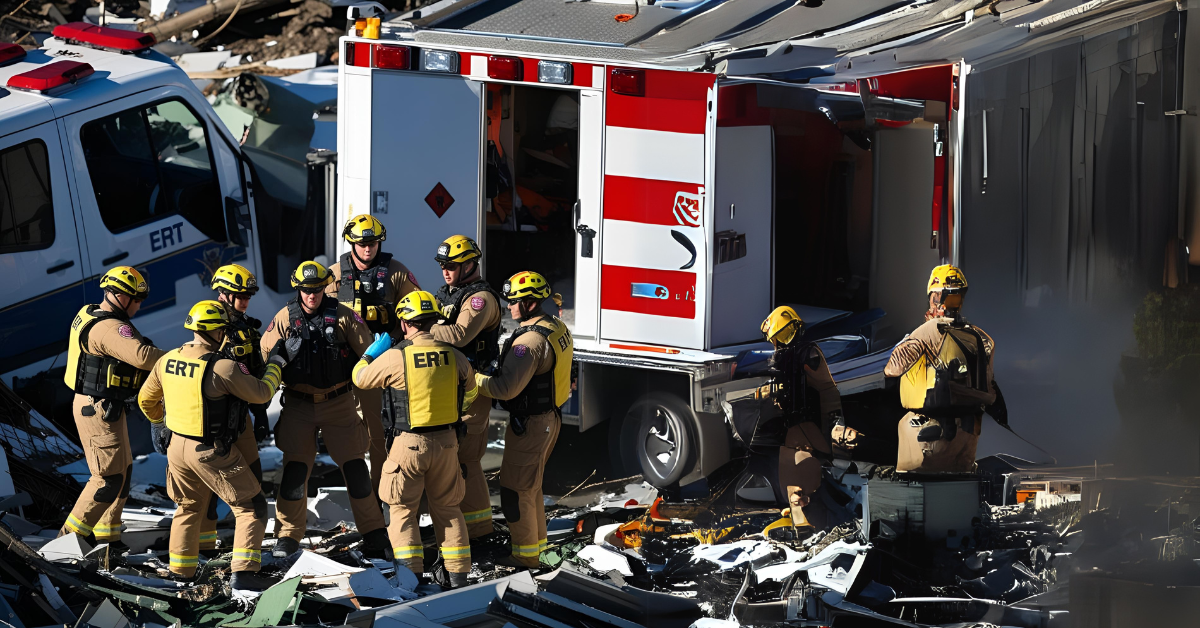Beginner

Level 2 Certificate in Emergency Response Team (ERT) Operations
Level 2 Certificate in Emergency Response Team (ERT) OperationsCourse OverviewThe Level 2 Certificate in Emergency Response Team (ERT) Operations is designed to provide learners with the essential skills and knowledge required to operate effectively as part of an emergency response team. The course focuses on equipping individuals with the competencies needed to respond to a range of emergency situations, from industrial accidents to medical emergencies and natural disasters. Learners will gain practical knowledge of emergency response procedures, safety protocols, team coordination, and effective communication, preparing them for roles in emergency management and response.Benefits
Who is This Designed For?This certificate is ideal for:
- Develop the skills to effectively respond to and manage emergency situations.
- Learn how to work as part of an Emergency Response Team (ERT) and coordinate with other emergency services.
- Gain knowledge of emergency response protocols, including evacuation, first aid, and fire safety.
- Enhance your ability to assess risks, perform under pressure, and ensure the safety of individuals during emergencies.
- Prepare for roles in emergency management or response teams across various industries such as manufacturing, healthcare, or government services.
- Understand the roles and responsibilities of an Emergency Response Team (ERT) and individual team members.
- Identify and assess emergency risks and hazards within different environments.
- Implement effective emergency response procedures for various types of emergencies.
- Coordinate with other emergency services and communicate effectively during an emergency situation.
- Perform basic first aid and life-saving techniques in emergency situations.
- Contribute to the development and implementation of emergency response plans.
- Introduction to Emergency Response Teams (ERTs)
- Overview of Emergency Response Teams: purpose, structure, and responsibilities.
- The role of ERTs in various industries (e.g., manufacturing, healthcare, government, public safety).
- Key characteristics of an effective ERT: teamwork, communication, and preparedness.
- Risk Assessment and Hazard Identification
- Understanding risk assessment in emergency response.
- Identifying common workplace hazards that may lead to emergencies (e.g., chemical spills, fires, medical emergencies).
- Techniques for hazard identification and risk prioritization.
- Establishing preventive measures to minimize risks.
- Emergency Response Procedures
- Core emergency response procedures: evacuation, firefighting, chemical spill containment, and medical response.
- Understanding evacuation protocols: assembly points, evacuation routes, and accountability procedures.
- Fire safety procedures: the use of fire extinguishers, fire alarms, and dealing with fire-related emergencies.
- Teamwork and Communication in Emergency Situations
- Importance of clear communication during an emergency.
- Communication methods used in ERT operations: radios, walkie-talkies, and other communication devices.
- Effective coordination between team members and other emergency services (e.g., fire department, medical teams, police).
- Roles of leadership and followership within the emergency response team.
- First Aid and Life-Saving Techniques
- Basic first aid principles and techniques for treating injuries (e.g., cuts, burns, fractures, bleeding).
- Performing CPR (Cardiopulmonary Resuscitation) and using an Automated External Defibrillator (AED).
- Providing first aid for common medical emergencies such as choking, heart attacks, and seizures.
- Managing casualties and ensuring their safety before professional medical help arrives.
- Personal Protective Equipment (PPE) and Safety Protocols
- Overview of Personal Protective Equipment (PPE) and its importance during emergencies.
- Proper use of PPE (e.g., helmets, gloves, respiratory protection, fire-resistant clothing).
- Understanding safety protocols for handling hazardous materials, chemicals, and dangerous environments.
- Emergency Response Planning and Drills
- The process of creating an emergency response plan (ERP).
- Key components of an ERP: risk assessments, evacuation routes, team roles, and responsibilities.
- Organizing and participating in regular emergency response drills.
- Evaluating the effectiveness of response plans and improving future emergency responses.
| Unit Title | GLH | TQT | Credit | Assessment Type |
| Introduction to Emergency Response Teams (ERTs) | 7 | 12 | 1.5 | MCQ |
| Risk Assessment and Hazard Identification | 9 | 16 | 2 | MCQ |
| Emergency Response Procedures | 10 | 18 | 2 | MCQ |
| Teamwork and Communication in Emergencies | 7 | 12 | 1.5 | MCQ |
| First Aid and Life-Saving Techniques | 8 | 14 | 2 | MCQ |
| PPE and Safety Protocols | 7 | 12 | 1.5 | MCQ |
| Emergency Response Planning and Drills | 7 | 12 | 1.5 | MCQ |
- Individuals looking to join or currently working in an Emergency Response Team (ERT).
- Health and safety professionals, fire wardens, and team leaders involved in emergency management.
- Employees in high-risk industries, such as manufacturing, construction, healthcare, or hospitality.
- Individuals wishing to gain knowledge and practical experience in emergency response procedures.
- Take on roles within Emergency Response Teams, such as Team Leader, ERT Member, or Emergency Coordinator.
- Progress to higher qualifications in emergency management, health and safety, or fire safety.
- Enhance their career in industries requiring emergency preparedness and response, including construction, manufacturing, and healthcare.
- Pursue further certifications in first aid, fire safety, or advanced emergency management.
- Expert-Led Learning: Learn from professionals with hands-on experience in emergency response and management.
- Practical Skills Development: Gain real-world experience through case studies, role-playing, and emergency drills.
- Industry-Relevant Knowledge: Learn emergency response procedures relevant to various industries, from industrial settings to healthcare environments.
- Comprehensive Certification: Obtain a well-rounded qualification that is recognized across various sectors, enhancing your employability in emergency management roles.
Qualification Title: Level 2 Certificate in Emergency Response Team (ERT) Operations
Level: 2
Type: Certificate
Total Qualification Time (TQT): 110 hours
Guided Learning Hours (GLH): 55 hours
Credit Value: 11 credits
Assessment Method: Multiple Choice Questions (MCQ)
Grading: Pass/Fail
Delivery Mode: Classroom / Online / Blended
Study Units Breakdown
| Unit Title | GLH | TQT | Credit | Assessment Type |
| Introduction to Emergency Response Teams (ERTs) | 7 | 12 | 1.5 | MCQ |
| Risk Assessment and Hazard Identification | 9 | 16 | 2 | MCQ |
| Emergency Response Procedures | 10 | 18 | 2 | MCQ |
| Teamwork and Communication in Emergencies | 7 | 12 | 1.5 | MCQ |
| First Aid and Life-Saving Techniques | 8 | 14 | 2 | MCQ |
| PPE and Safety Protocols | 7 | 12 | 1.5 | MCQ |
| Emergency Response Planning and Drills | 7 | 12 | 1.5 | MCQ |
Upon completing this certificate, learners will be able to:
- Understand the roles and responsibilities of an Emergency Response Team (ERT) and individual team members.
- Identify and assess emergency risks and hazards within different environments.
- Implement effective emergency response procedures for various types of emergencies.
- Coordinate with other emergency services and communicate effectively during an emergency situation.
- Perform basic first aid and life-saving techniques in emergency situations.
- Contribute to the development and implementation of emergency response plans.
Who is This Designed For?
This certificate is ideal for:
- Individuals looking to join or currently working in an Emergency Response Team (ERT).
- Health and safety professionals, fire wardens, and team leaders involved in emergency management.
- Employees in high-risk industries, such as manufacturing, construction, healthcare, or hospitality.
- Individuals wishing to gain knowledge and practical experience in emergency response procedures.
Assessment Type: MCQ-based
Top Courses
Related Courses
Let's Get in touch
Deleting Course Review
Are you sure? You can't restore this back
Course Access
This course is password protected. To access it please enter your password below:



